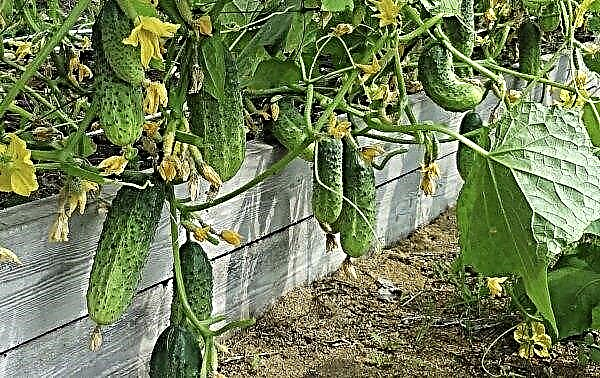Beekeeping is a painstaking work requiring certain knowledge and experience. In addition, many farms face various troubles in the form of parasites, diseases that can be dangerous for the bee family. One of the most common of the last few decades is bee varroatosis. What is this ailment and how to deal with it is discussed below.
What is varroatosis and how many days does he live with bees?
Varroatosis is a parasitic disease of honey bees caused by ticks Varroasis apium. A brown tick 1 × 1.5 mm in size is attached to the bee's body and feeds on hemolymph, thereby weakening the individual. Females of the parasite are viable for a year, males usually live no more than 20 days.
Did you know? Bees communicate with each other through certain movements. So, to attract the attention of fellow tribesmen to the source of nectar, they begin to perform a “dance”, rotating in a circle.
Signs and methods of infection
Identifying the parasite is not an easy task for those who are faced with the problem for the first time, however, there are some signs by which the presence of ticks can be determined:
- the appearance on the body of bees of brown plaques, most often in the area of the cephalothorax, also ticks can be seen in the hive tray and the arrival board;
- dead individuals may appear around the hive, which the bees throw out of the dwelling;
- ticks most often affect a sealed brood, so when opening a cell of a honeycomb, a parasite can be found on the pupae;
- in an infected family, the appearance of small, weakened individuals with damaged wings can be observed.
 Infection with varroatosis occurs by entering an infected individual from the outside in the family. Most often, bees from infected hives, accidentally caught in a healthy one, or working individuals, to which the parasite attached itself during the collection of nectar, carry the bees. There are cases when the host strengthens the family with an infected brood.
Infection with varroatosis occurs by entering an infected individual from the outside in the family. Most often, bees from infected hives, accidentally caught in a healthy one, or working individuals, to which the parasite attached itself during the collection of nectar, carry the bees. There are cases when the host strengthens the family with an infected brood.Important! The behavior in the family where the disease spreads becomes restless, the bees become irritable, which is the reason for a thorough check of the hive.
How to determine the presence of a tick?
To identify the defeat of varroatosis, it is necessary to take a number of special measures, after which a decision is made on the need and method of treatment:
- a thorough inspection of the inhabitants of the hive, especially drones brood, as females of the parasite prefer it for laying eggs (on the pupae you can find developing ticks);
- in the early stages of infection, apiaries use a simple method: white paper is covered on the bottom of the hive, after which the bees are treated with one of the acaricides (for example, Apitak), the affected ticks will disappear and remain on paper;
- Another simple and informative diagnostic method is to calculate the percentage of infected hive population. For this purpose, about a hundred individuals are selected from the middle of the hive, which are placed in a container with boiling water with the addition of soda or washing powder. After mixing, the parasites separate and settle at the bottom. Counting the number of ticks and bees allows you to determine the approximate degree of infection.

How to treat bees for varroatosis?
Experienced beekeepers are aware that the prevention of this disease is much simpler than the fight against it. However, the widespread use of ticks makes it necessary to treat apiaries with various methods and means.
Chemicals
The most common way to treat varroatosis in large apiary conditions is to use ready-made special preparations of acaricides, which may include thymol, amitraz, flumetrin: Antivaro, Apidez, Bipin-Timol and others. Most of these products are available in liquid form and are intended for irrigation of bees with a prepared solution. In this case, the sealed brood is not subjected to spraying and treatment will be ineffective.
Important! In beekeeping, it is generally accepted that if the number of infected individuals is below 4%, then treatment can be omitted.
Therefore, treatment with liquid preparations is carried out in several stages: after pumping out honey and in the fall, immediately before wintering. Sometimes, with strong reproduction of the tick or with weak autumn processing, a second procedure is carried out in early spring. In the summer, processing is not carried out, since many drugs get into bee products, making them unsuitable. Plates with acaricide (for example, Vetfor), which are placed on the hive, are very popular. Bees come in contact with the plate, as a result of which the drug is distributed to all individuals. In this case, the tool is detrimental to the tick, but safe for the family. Such a tool is placed in a hive in early spring and removed in May, when acacia blooms, and then at the end of the season, in early autumn. For wintering, the plates are removed because they are ineffective at temperatures below + 10ºС.
Plates with acaricide (for example, Vetfor), which are placed on the hive, are very popular. Bees come in contact with the plate, as a result of which the drug is distributed to all individuals. In this case, the tool is detrimental to the tick, but safe for the family. Such a tool is placed in a hive in early spring and removed in May, when acacia blooms, and then at the end of the season, in early autumn. For wintering, the plates are removed because they are ineffective at temperatures below + 10ºС.
Folk remedies
Among beekeepers, along with chemical agents, popular methods of treating bees for Varroa ticks remain popular:
- dried peppers have a high anti-varroatosis effect. On the basis of the crushed raw materials, an infusion is made (50 g per 1 liter of boiling water), and used as an additive to top dressing (50 ml of the product per 1 liter of sugar syrup). In addition, the infusion can irrigate the bees themselves;
- thyme also has a powerful anti-mite effect, due to the high content of thymol in it. Dried grass in an amount of 50 g is infused in 1 liter of boiling water for 15-20 minutes, the resulting mixture is filtered and added to sugar syrup (50 ml per 1 liter of fertilizing);
- pine buds and needles they are crushed, boiled in boiling water for 20 minutes, after which they need to be infused (4 parts of water are taken for 1 part of the raw material). The resulting strained broth is added to the bee top dressing in an amount of 30 ml per 1 liter of syrup.
Did you know? Bees have poor eyesight and are mainly oriented by smell, but they are best distinguished by blue, yellow and white colors.
Physical methods
These methods provide a direct effect on ticks; they are not used very often in beekeeping due to the high complexity and relatively low efficiency in relation to the infected sealed brood:
- pollination of bees with various powders. Most often, coniferous flour, chalk, talc are used, which, getting on bees, also penetrate the respiratory organs of the tick and fill them, as a result of which the parasite dies and disappears;
- heat treatment of the whole family. Bees are able to withstand a higher temperature than Varroa, therefore, to combat the pest, they process individuals in a heat chamber in a special cassette at a temperature of + 48 ° C. The procedure takes 20 minutes, as a result of processing the ticks die.

Zootechnical methods
This method involves the creation of conditions to reduce the number of families due to a targeted temporary decrease in brood, since it is in it that female ticks lay their eggs. So, at the beginning of summer, all broods are brought to a zone remote from the apiary, leaving only fresh to receive the uterus. Thus, the number of ticks is significantly reduced.
What could be the consequences?
Untimely diagnosis of varroatosis and the lack of treatment can lead to disastrous results:
- brood infection leads to the appearance of weak individuals with obvious defects in the wings and trunk, unable to fulfill their function;
- often with severe infection, ticks begin to encroach on unsealed brood, which leads to the death of larvae;
- during wintering, parasites can move to adult bees, which, due to exhaustion, may not survive until spring, which ultimately leads to a strong reduction and even death of the bee family.
Preventive measures
There is no specific prophylaxis that can exclude invasion, however, some measures will reduce the likelihood of infection and the intensity of the spread of the parasite:
- planting apiary possessing odors and properties that repel ticks: wormwood, mint, thyme, elderberry, juniper, calendula;
- separate frameworks for drone brood with its subsequent removal allows to reduce the number of pests;
- in the autumn period after pumping out honey and in the early spring, preventive measures are taken to maintain the family’s immunity using top dressing, which includes acaricides (for more detailed examples, see the section on folk remedies).
 Varroatosis is a formidable and very common disease that can destroy entire families in an apiary and cause serious damage. In order to avoid negative consequences, beekeepers should be extremely careful at all stages of the development of bee offspring and conduct timely treatment measures, preventing excessive reproduction of the tick.
Varroatosis is a formidable and very common disease that can destroy entire families in an apiary and cause serious damage. In order to avoid negative consequences, beekeepers should be extremely careful at all stages of the development of bee offspring and conduct timely treatment measures, preventing excessive reproduction of the tick.












